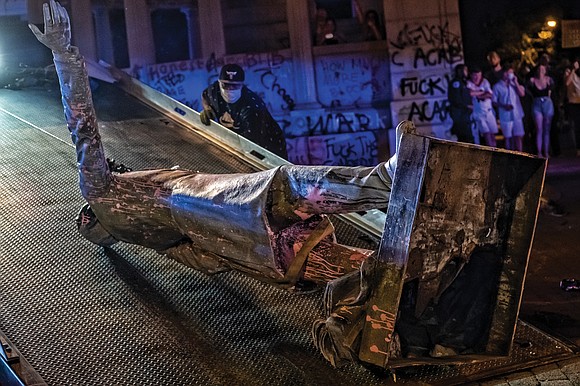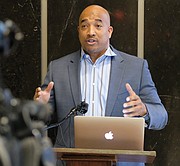City’s Confederate statues now up for disposal
Jeremy M. Lazarus | 8/6/2020, 6 p.m.
Let the disposal begin.
The Richmond City Council on Monday set in motion a plan to finally rid Richmond of most of the city-owned statues and icons of Confederate traitors, although surprisingly, not all.
As expected, the council voted 9-0 to approve the permanent removal of the Confederate statues and to start the process to receive bids for 10 of the 12 items under city control. That includes the four former Monument Avenue statues of Jefferson Davis, Thomas J. “Stonewall” Jackson, Matthew Fontaine Maury and J.E.B. Stuart.
After the vote, Lawrence Anderson, City Council’s chief of staff, said that he would work with council to create a process that would allow governments, museums or private organizations to bid for the statues.
Mr. Anderson said he and other staff would vet the applications and offer recommendations for sale to the council. He said the first recommendations could come as early as Sept. 8.
City Council has to wait 30 days after the vote to begin a sale, but is under no deadline to actually undertake that action. The vote was based on a new state law that allows localities to remove war memorials. However, the city’s process might have to be redone to address two Confederate statues that were left off the original list for removal – those honoring Richmond railroad tycoon and Confederate Gen. Williams C. Wickham and a Confederate unit known as the Richmond Howitzers.
City Council also did not consider how to deal with the statue of Christopher Columbus that was torn down in early June by protesters from its pedestal in Byrd Park. Disposal of the Columbus statue would require a separate process as it is not a war memorial.
Still, City Council’s action represents a clear victory for 9th District Councilman Michael J. Jones, who began advocating for the removal of the Confederate statues three years ago when only one other council member supported the idea.
This time, the eight other council members signed on as co-sponsors of the legislation Dr. Jones sponsored. Mayor Levar M.
Stoney, who had announced in late June that he also would co-patron the ordinance with Dr. Jones, is not listed as a sponsor. In July, Mayor Stoney used emergency authority granted to him on June 8 by City Council to remove all the city-owned Confederate statues except that of Confederate Gen. A.P. Hill at Laburnum Avenue and Hermitage Road in North Side, where Gen. Hill’s remains are buried.
Dr. Jones did not speak during the meeting on a triumph he sees as benefiting the city. Most of the other council members also kept silent on the historic action to remove the Confederate images that have long dominated the city’s landscape and which are to be followed in the months to come with elimination of Confederate names from a major bridge and a stretch of U.S. 1, a major north-south road.
Council Vice President Chris A. Hilbert did take a moment to mark the occasion.
“These statues were placed in the public square as an affront to individuals in this city who were reduced to ‘Jim Crow’ status. They sent a definite message that white people were in charge,” Mr. Hilbert said.
He called it time to move forward and to end the monuments to a lost cause and to a “breakaway country. It was illegal. We need to own up to that,” he said.
“We should not honor those who led an armed insurrection against federal authority where so many were killed. We need to honor history, not those who fought for the perpetuation of slavery.”
The full list of the 10 items to be disposed of includes the four Monument Avenue statues plus to two cannon that were in the median; the statue of Gen. Hill; a stone cross to Fitzhugh Lee and a statue of Joseph Bryan that were in Monroe Park; and the Confederate Soldiers and Sailors Monument in Church Hill.
During a public hearing before the vote, Richmond representatives of the Italian- American Cultural Association and the Giuseppe Verdi Society, unaware that the Columbus statue was not up for disposal, urged the council to return the statue to them so it could be placed on society property in Mechanicsville.
“This statue was a gift to Richmond from the sons and daughters of Italy who were making a new life here,” Aldo F. Funai of the society told the council. “They paid for it and it should be returned to our organization if the city no longer wants it.”
The Free Press was told the council would need to rescind the 93-year-old ordinance of acceptance of the statue to make that happen.
The council also heard from a representative of relatives of Confederate Gen. J.E.B. Stuart, who urged the council to turn that statue over to them so it can be placed at Laurel Hill, his birthplace in Patrick County. Dr. Jones endorsed the idea.
Only three of the speakers urged City Council to reconsider removing the statues. Among them was Betsy Blevins, who told council she represented white people “who believe in racial equality and needed to speak up after weeks of destruction that went on under the veil of the Black Lives Matter movement.”
She said the council needs to ensure individuals’ rights are preserved and that decisions are made that are “fair and honest.” Ms. Blevins decried Mayor Stoney’s sudden removal of the Confederate statuary instead of following the guidance of the Monument Avenue Commission he appointed that recommended four of the five statues remain with contextual signs added.
Another woman told City Council that it was blowing the opportunity to create a “learning laboratory” on the Civil War that could become a major attraction.
That was the point that another speaker made, noting a Wall Street Journal article estimating that 7 million people yearly spend $2.6 billion in visiting Civil War sites.
He said instead of removing the statues, City Council should promote them to draw more tourists and gain a larger share of those dollars.
“Given the current fiscal needs of the city,” he said, elected of- ficials are making a grave mistake in “ridding the city of a potential cash cow. Think long and hard about what you are doing.”
Meanwhile, Richmond sculptor Paul DiPasquale urged the council to write into any future sales documents a requirement that the purchaser preserve the item.








